Blanc-Sablon, Quebec
Blanc-Sablon is the easternmost community in Le Golfe-du-Saint-Laurent Regional County Municipality, in the administrative région of Côte-Nord, in the province of Quebec, Canada. With a population of 1,118 inhabitants,[3] it is the most populous community in the county municipality.
Blanc-Sablon | |
|---|---|
Municipality | |
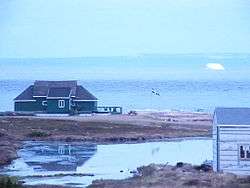 | |
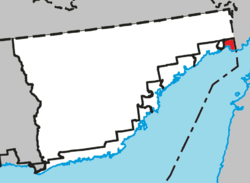 Location within Le Golfe-du-Saint-Laurent RCM. | |
 Blanc-Sablon Location in Côte-Nord Region of Quebec.  Blanc-Sablon Blanc-Sablon (Quebec)  Blanc-Sablon Blanc-Sablon (Canada) | |
| Coordinates: 51°25′N 57°08′W[1] | |
| Country | |
| Province | |
| Region | Côte-Nord |
| RCM | Le Golfe-du-Saint-Laurent |
| Settled | 19th century |
| Constituted | January 1, 1990 |
| Government | |
| • Mayor | Wanda Beaudoin |
| • Federal riding | Manicouagan |
| • Prov. riding | Duplessis |
| Area | |
| • Total | 376.50 km2 (145.37 sq mi) |
| • Land | 247.63 km2 (95.61 sq mi) |
| Elevation | 2 m (7 ft) |
| Population (2011)[3] | |
| • Total | 1,118 |
| • Density | 4.5/km2 (12/sq mi) |
| • Pop 2006-2011 | |
| • Dwellings | 508 |
| Time zone | UTC-4 (AST) |
| Postal code(s) | G0G 1W0 |
| Area code(s) | 418 and 581 |
| Highways | |
| GNBC Code | EOACK |
| NTS Map | 012P06 |
Geography
Blanc-Sablon is located on the north coast of the Gulf of Saint Lawrence near the entrance of the Strait of Belle Isle. Two significant bays, Brador and Blanc-Sablon, mark its shores and the headland that separates these bays is dominated by Mont Parent, a 100-metre (328 ft) high flat-topped hill named after Martin Parent, a local fisherman in the middle of the 19th century.[4] The municipality borders Côte-Nord-du-Golfe-du-Saint-Laurent, Quebec to the south-west, and L'Anse-au-Clair, Labrador to the north-east.
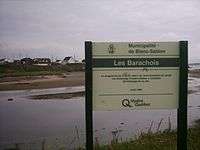
The estuary of the Brador River and Blanc-Sablon River has a lagoon designated barachois, separated from the sea by sand or gravel. Seawater enters at high tide.
The Blanc-Sablon archipelago is located off the coasts of the villages of Blanc-Sablon and Brador and includes Long Island, Lazy Island, Basin Island, Island of the Parrots, Wood Island and Greenly, housing the Bird Sanctuary of Brador Bay.
The municipality of Blanc-Sablon has several land protrusions into the Gulf of St. Lawrence; from east to west, they are Point Saint-Charles, Morel's Point, Lazy Point , Hunting Point, "À la Barque" Point, Cape Crow and Point Jones.
Accessibility
Ferry services
Being at the eastern end of the Côte-Nord region, Blanc-Sablon is served by a ferry for the communities along the north shore of the Gulf of St. Lawrence, connecting with the coastal communities of Saint-Augustin, Gros-Mécatina, Tête-à-la-Baleine, Harrington Harbour, La Romaine and Kegashka, as well as Anticosti Island at Port-Menier. This service is funded by the Government of Quebec. The ferry service's main goal is to make up for the gap in Route 138, which remains unbuilt between Kegaska and Old Fort (in Bonne-Espérance).
Blanc-Sablon is also the northern terminus of a ferry service across the Strait of Belle Isle to the island of Newfoundland, mainly serving as a connection with nearby Labrador.[5] This 28 km (17 mi)-long ferry service, operated by the MV Qajaq W, is funded entirely by the government of Newfoundland and Labrador and connects with a southern terminus at St. Barbe on Newfoundland Island's Great Northern Peninsula. During winter months, ice conditions sometimes require the service to divert to Corner Brook instead of St. Barbe.[6]
Road access
So far, the Municipality of Blanc-Sablon is inaccessible directly via the rest of the Quebec road network. From the west, Route 138 has been built to the village of Kegashka; then following a 425 km (264 mi) gap, a 69 km (43 mi) segment restarts at the village of Old Fort and continues to Blanc-Sablon, ending at the border with Labrador where it becomes the Trans-Labrador Highway (Route 510). To connect the rest of Quebec from Blanc-Sablon, a traveller can take the Relais Nordik ferry (not drive-on/off, but can accommodate cars in shipping containers), or drive via Route 510 1,128 km (701 mi) that connects Wabush on the border of Labrador and Quebec; then Route 389 of 594 km (369 mi) connects Wabush and Baie-Comeau to Quebec, passing to the east of Manicouagan Reservoir. This trip by the north (between Baie-Comeau and Blanc-Sablon) is 1,722 km (1,070 mi). Once Route 138 is completed, the road distance between Baie-Comeau and Blanc-Sablon is estimated to be between 1,045 km (649 mi) to 1,067 km (663 mi); thereby reducing the distance about 38%.
The Government of Quebec invests annually for the future extension of Route 138 to Blanc-Sablon.
Air travel
The Lourdes-de-Blanc-Sablon Airport provides scheduled air service to Blanc-Sablon.
History
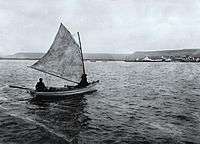
The place was already known to early European explorers who may have named it after the fine white sand of the eponymous bay (blanc means "white", whereas sablon is the diminutive form of sable meaning "sand"). Or it may be named after Blancs-Sablons Cove in Saint-Malo, home town of Jacques Cartier, who landed at the place in 1534 and set up a cross near the current site of Lourdes-de-Blanc-Sablon.[1]
During the 16th and 17th centuries, Basque and Portuguese fishermen seasonally frequented the area. In 1704, Augustin Le Gardeur de Courtemanche, landlord of the lower Côte-Nord at that time, built Fort Pontchartrain at the current location of Brador. Permanent settlement did not begin until the 19th century with the arrival of French-Canadians, Acadians, and Jersey settlers. In 1858, the Mission of Longue-Pointe-de-Blanc-Sablon was established and took the name Lourdes-de-Blanc-Sablon or Notre-Dame-de-Lourdes at the end of 19th century. In 1884, the post office opened.[1][7]
The area was first incorporated in 1963 as part of the Municipality of Côte-Nord-du-Golfe-Saint-Laurent, but separated on January 1, 1990, and became the Municipality of Blanc-Sablon.[1]
Fifty hectares of land in Blanc-Sablon were designated a National Historic Site of Canada in 2007, as they contain over 60 archaeological sites relating to 9000 years of human occupation, including the Archaic, Dorset and European periods.[8]
In August 2014, Blanc-Sablon mayor Armand Joncas expressed his personal discontent over neglect of the Basse-Côte-Nord area by the Quebec government, and discussed the secession of the Basse-Côte-Nord from Quebec to join the province of Newfoundland and Labrador, even though the mayor does not have any political or judicial powers to do so. Joncas cited a lack of a continuous road network to Quebec, isolation and lack of interest from the Quebec government and close logistics and cultural identity with the people of Labrador as his reasons.[9]
Communities
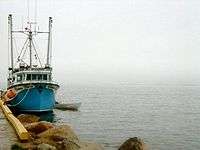
The municipality includes three villages: Blanc-Sablon, Lourdes-de-Blanc-Sablon, and Brador Bay.
Lourdes-de-Blanc-Sablon
Lourdes-de-Blanc-Sablon (51°24′41″N 57°12′11″W) is the largest community in the municipality, and is located on the headland that separates Brador Bay from Blanc-Sablon Bay. It was originally known as Longue-Pointe (Long Point) until the beginning of the 20th century. It has a small natural harbour, and long depended on the fishing business.[10]
Brador
Brador or Brador Bay (51°27′40″N 57°14′44″W) is on the eastern shore of the namesake bay, 7 kilometers (4.3 mi) north of the village of Lourdes-de-Blanc-Sablon. While known in the 18th century as Fort Pontchartrain and Phélipeaux Bay, its current name is the shortened form of Labrador. In French, the syllable la is a definite article, and in documents from the 17th and 18th century, this syllable was considered as such and separated from the rest of the name. François Martel de Brouague, the King's Commander of this region from 1714 to 1760, referred to this location as: "A la Baye de Phélipeaux, coste de la Brador" ("At the Bay of Phélipeaux, coast of the Brador").[11]
Demographics
Population
| Canada census – Blanc-Sablon, Quebec community profile | |||
|---|---|---|---|
| 2011 | 2006 | ||
| Population: | 1,118 (-11.5% from 2006) | 1,263 (+5.2% from 2001) | |
| Land area: | 247.63 km2 (95.61 sq mi) | 247.63 km2 (95.61 sq mi) | |
| Population density: | 4.5/km2 (12/sq mi) | 5.1/km2 (13/sq mi) | |
| Median age: | 43.5 (M: 43.7, F: 43.4) | 37.9 (M: 37.1, F: 38.7) | |
| Total private dwellings: | 508 | 482 | |
| Median household income: | $.N/A | $50,817 | |
| Notes: 2011 income data for this area has been suppressed for data quality or confidentiality reasons. – References: 2011[12] 2006[13] earlier[14] | |||
|
|
|
|
|
Language
| Canada Census Mother Tongue - Blanc-Sablon, Quebec[15] | ||||||||||||||||||
|---|---|---|---|---|---|---|---|---|---|---|---|---|---|---|---|---|---|---|
| Census | Total | French |
English |
French & English |
Other | |||||||||||||
| Year | Responses | Count | Trend | Pop % | Count | Trend | Pop % | Count | Trend | Pop % | Count | Trend | Pop % | |||||
2011 |
1,080 |
315 | 29.17% | 740 | 68.52% | 20 | 1.85% | 5 | 0.46% | |||||||||
2006 |
1,245 |
330 | 26.51% | 880 | 70.68% | 35 | 2.81% | 0 | 0.00% | |||||||||
2001 |
1,185 |
395 | 33.33% | 740 | 62.45% | 50 | 4.22% | 0 | 0.00% | |||||||||
1996 |
1,240 |
350 | n/a | 28.23% | 855 | n/a | 68.95% | 35 | n/a | 2.82% | 0 | n/a | 0.00% | |||||
Climate
Blanc-Sablon experiences a subarctic climate (Köppen climate classification Dfc). It has short, cool summers, and very long and harsh winters. Although its latitude is only 51 degrees north, and its climate is tempered by the Atlantic Ocean, it experiences a much colder climate than other cities of the same latitude due to the cold Labrador Current. For example, London, England, on the same latitude, has an annual mean that is nearly 10˚C (18˚F) milder.
| Climate data for Blanc-Sablon Airport (1981−2010) | |||||||||||||
|---|---|---|---|---|---|---|---|---|---|---|---|---|---|
| Month | Jan | Feb | Mar | Apr | May | Jun | Jul | Aug | Sep | Oct | Nov | Dec | Year |
| Record high humidex | 9.6 | 12.6 | 7.3 | 18.6 | 24.4 | 28.0 | 31.4 | 30.3 | 28.7 | 20.3 | 18.0 | 7.8 | 31.4 |
| Record high °C (°F) | 9.1 (48.4) |
8.3 (46.9) |
10.4 (50.7) |
19.2 (66.6) |
20.5 (68.9) |
26.0 (78.8) |
27.1 (80.8) |
28.1 (82.6) |
23.3 (73.9) |
21.0 (69.8) |
16.2 (61.2) |
7.8 (46.0) |
28.1 (82.6) |
| Average high °C (°F) | −7.7 (18.1) |
−7.4 (18.7) |
−3.0 (26.6) |
2.5 (36.5) |
7.9 (46.2) |
12.3 (54.1) |
15.7 (60.3) |
16.6 (61.9) |
12.9 (55.2) |
7.1 (44.8) |
2.1 (35.8) |
−3.8 (25.2) |
4.6 (40.3) |
| Daily mean °C (°F) | −12.7 (9.1) |
−12 (10) |
−7.3 (18.9) |
−1.0 (30.2) |
3.8 (38.8) |
8.3 (46.9) |
12.0 (53.6) |
12.8 (55.0) |
9.0 (48.2) |
3.6 (38.5) |
−1.5 (29.3) |
−8.1 (17.4) |
0.6 (33.1) |
| Average low °C (°F) | −17.5 (0.5) |
−16.5 (2.3) |
−11.4 (11.5) |
−4.4 (24.1) |
−0.3 (31.5) |
4.2 (39.6) |
8.1 (46.6) |
9.0 (48.2) |
5.0 (41.0) |
0.2 (32.4) |
−5.1 (22.8) |
−12.4 (9.7) |
−3.4 (25.9) |
| Record low °C (°F) | −32.3 (−26.1) |
−34.1 (−29.4) |
−32.5 (−26.5) |
−23.0 (−9.4) |
−11.1 (12.0) |
−3.6 (25.5) |
0.0 (32.0) |
1.8 (35.2) |
−4.8 (23.4) |
−10.4 (13.3) |
−18.9 (−2.0) |
−30.2 (−22.4) |
−34.1 (−29.4) |
| Record low wind chill | −48 | −48 | −48 | −34 | −16 | −7 | 0 | 0 | −9 | −22 | −31 | −47 | −48 |
| Average precipitation mm (inches) | 97.2 (3.83) |
83.8 (3.30) |
80.1 (3.15) |
49.9 (1.96) |
69.4 (2.73) |
92.0 (3.62) |
102.0 (4.02) |
96.3 (3.79) |
88.8 (3.50) |
87.8 (3.46) |
74.9 (2.95) |
99.6 (3.92) |
1,021.7 (40.22) |
| Average rainfall mm (inches) | 11.8 (0.46) |
7.9 (0.31) |
11.5 (0.45) |
20.5 (0.81) |
62.0 (2.44) |
91.4 (3.60) |
101.9 (4.01) |
96.3 (3.79) |
88.8 (3.50) |
81.9 (3.22) |
48.0 (1.89) |
24.1 (0.95) |
646.0 (25.43) |
| Average snowfall cm (inches) | 85.4 (33.6) |
75.7 (29.8) |
68.6 (27.0) |
29.1 (11.5) |
7.4 (2.9) |
0.66 (0.26) |
0.02 (0.01) |
0.0 (0.0) |
0.03 (0.01) |
6.0 (2.4) |
26.9 (10.6) |
75.5 (29.7) |
375.3 (147.8) |
| Average precipitation days (≥ 0.2 mm) | 17.5 | 16.9 | 17.0 | 13.9 | 15.1 | 16.0 | 17.4 | 15.1 | 14.5 | 15.5 | 15.8 | 17.9 | 192.7 |
| Average rainy days (≥ 0.2 mm) | 2.8 | 2.4 | 4.5 | 7.3 | 13.2 | 16.0 | 17.4 | 15.1 | 14.5 | 14.5 | 9.8 | 5.2 | 122.5 |
| Average snowy days (≥ 0.2 cm) | 16.5 | 15.9 | 15.1 | 8.7 | 2.9 | 0.32 | 0.04 | 0.0 | 0.04 | 2.3 | 8.6 | 15.6 | 86.1 |
| Mean monthly sunshine hours | 93.9 | 106.7 | 111.7 | 137.6 | 157.5 | 165.3 | 141.9 | 159.0 | 128.9 | 106.2 | 85.1 | 75.8 | 1,469.4 |
| Percent possible sunshine | 36.0 | 37.9 | 30.4 | 33.1 | 32.6 | 33.3 | 28.4 | 35.2 | 33.9 | 32.0 | 31.8 | 30.8 | 32.9 |
| Source: Environment Canada[16] | |||||||||||||
Education
Commission scolaire du Littoral operates:[17]
- Mgr-Scheffer School (anglophone and francophone) in Lourdes-de-Blanc-Sablon
- St-Theresa School (for adults) in Blanc-Sablon
See also
Related articles
- Côte-Nord (North-Shore), administrative region
- Gulf of Saint Lawrence
- Strait of Belle Isle
- Brador River
- Blanc-Sablon River
- Blanc-Sablon Bay
- Border between Quebec and Newfoundland and Labrador
- Lourdes-de-Blanc-Sablon Airport
- List of municipalities in Quebec
References
- "Blanc-Sablon (Municipalité)" (in French). Commission de toponymie du Québec. Retrieved 2010-09-30.
- "Blanc-Sablon". Répertoire des municipalités (in French). Gouvernement du Québec, Ministère des Affaires municipales, des Régions et de l'Occupation du territoire. Archived from the original on 2012-05-01. Retrieved 2010-09-29.
- "Blanc-Sablon census profile". 2011 Census of Population. Statistics Canada. Retrieved 2012-04-04.
- "Mont Parent (colline)" (in French). Commission de toponymie du Québec. Retrieved 2010-09-30.
- "St. Barbe - Blanc Sablon (Strait of Belle Isle Area)". Government of Newfoundland and Labrador. January 31, 2020. Retrieved February 25, 2020.
- "Alternate route being taken for Labrador ferry". SaltWire Network. February 20, 2020. Retrieved February 25, 2020.
- "Discover the region > Our villages > Blanc Sablon". Tourism Lower North Shore. Retrieved 2010-09-30.
- Blanc-Sablon. Canadian Register of Historic Places. Retrieved 5 March 2012.
- "Blanc Sablon wants to leave Quebec, join N.L." CBC News. Retrieved 20 August 2014.
- "Lourdes-de-Blanc-Sablon (village)" (in French). Commission de toponymie du Québec. Retrieved 2010-09-30.
- "Brador (hameau)" (in French). Commission de toponymie du Québec. Retrieved 2010-09-30.
- "2011 Community Profiles". 2011 Canadian Census. Statistics Canada. July 5, 2013. Retrieved 2014-01-28.
- "2006 Community Profiles". 2006 Canadian Census. Statistics Canada. March 30, 2011. Retrieved 2012-04-04.
- "2001 Community Profiles". 2001 Canadian Census. Statistics Canada. February 17, 2012.
- Statistics Canada: 1996, 2001, 2006, 2011 census
- "Blanc–Sablon A". Canadian Climate Normals 1981–2010. Environment Canada. Retrieved October 6, 2013.
- "Schools and centers." Commission scolaire du Littoral. Retrieved on September 23, 2017.